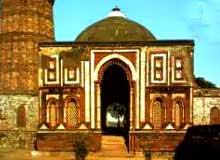 The medieval period saw great developments in the field of architecture. With the coming of Muslims to India, many new features came to be introduced in buildings. The development of Muslim Style of Architecture of this period can be called the Indo-Islamic Architecture or the IndianArchitecture influenced by Islamic Art. The Indo-Islamic style was neither strictly Islamic nor strictly Hindu. The architecture of the medieval period can be divided into two main categories. They are the Delhi or the Imperial Style and the Mughal Architecture. The Imperial Style developed under the patronage of the Sultans of Delhi. The Mughal Architecture was a blend of the Islamic Architecture of Central Asia and the Hindu Architecture of India.
The medieval period saw great developments in the field of architecture. With the coming of Muslims to India, many new features came to be introduced in buildings. The development of Muslim Style of Architecture of this period can be called the Indo-Islamic Architecture or the IndianArchitecture influenced by Islamic Art. The Indo-Islamic style was neither strictly Islamic nor strictly Hindu. The architecture of the medieval period can be divided into two main categories. They are the Delhi or the Imperial Style and the Mughal Architecture. The Imperial Style developed under the patronage of the Sultans of Delhi. The Mughal Architecture was a blend of the Islamic Architecture of Central Asia and the Hindu Architecture of India. The Indo-Islamic style provided spaciousness, massiveness and breadth to the Hindu architecture. In almost all the prominent buildings, the arch, Minar and dome began to be used and the mosque or Masjid became a part of the landscape. The chief means of decoration was surface decoration through the use of geometry, arabesque and calligraphy. The Muslims borrowed the design of kalash on the top of the Hindu temple by placing a dome on the top of their buildings.
The most important symbol of Indo-Islamic architecture in India is the tomb or the mausoleum which evolved from the basic cube and hemisphere of the early phase into a more detailed form during the Mughal period. In the Mughal period multiple chambers were made and tombs were set in gardens, known as the Char-Bagh. The tomb chamber houses the cenotaph below which is the grave. The most famous example of tomb in India is the Taj Mahal.
The Mughal Architecture occupies a significant place in the history of Indian Architecture. The Mughal architecturedeveloped with the efforts of Akbar. Akbar cleverly incorporated foreign influences into indigenous style. Some of thebasic features of the Mughal Architecture are the round domes, high minarets, mehrabs, pillars, open courtyards etc. A notable feature of the Mughal architecture was the use of red sandstone. It is interesting to note that red sandstone was used for construction of huge buildings and forts. However red sandstone was replaced with white marbles replaced it during the later period when the stress was more on beautifying of the buildings with the use of colored designs, precious and semi-precious stones, gold and silver waters and minute carvings.
The outstanding examples of Indo-Islamic architecture are the Qutub Minar, Alai Darwaza, Quwwat-ul-Islam mosque, Tughlaqabad Fort, Fatehpur Sikri, Agra Fort, Taj Mahal, Red Fort Delhi etc.

No comments:
Post a Comment